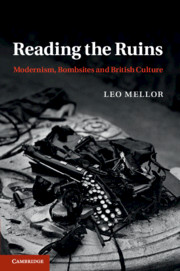Chapter 3 - Surrealism and the bombsites
Published online by Cambridge University Press: 07 October 2011
Summary
You know I’d have thought an air raid was just the thing for a surréaliste; it ought to give you plenty of compositions – limbs and things lying about in odd places you know.
Evelyn Waugh, Put Out More Flags (1942)On 13 June 1940, just as German tanks entered Paris but before the bombing of London had started in earnest, Zwemmers art gallery on Litchfield Street in Soho opened a long-planned exhibition. It was organised under the auspices of the British Surrealist Group (which was, at this very point, engaged in expelling over two-thirds of its own members for various forms of deviationism and lack of commitment). The exhibition showcased works from younger artists such as John Banting, Ithell Colquhoun and Eileen Agar as well as those by more established names including Henry Moore, Edward Burra and Paul Nash. Reviews ranged from the uncomfortably enthused, through the mixed, to the overtly dismissive: ‘At a moment like this Surrealism seems unnecessary … Surrealism can be a good psychological cocktail, but cocktail time is over’. However some who visited the gallery had reasons for a more vivid reaction. Soldiers just back from Dunkirk saw the works presented in a rather different light after their experience of battle. To them the shock of disjointed images and violent juxtapositions was now minimal: ‘“This isn’t strange to us,” they said, “it’s just like what we’ve been seeing over there.”’
This observation by some anonymous soldiers, far more than the relative success or failure of the exhibition, captures a key dynamic of Second World War culture: the way in which surrealism made a complex and intriguing transition. For it moved from being a newly imported foreign sensation in the 1930s to acquiring popular recognition as fearfully ‘premonitory’ at the outbreak of war – encoding the excess of fearful possibility beyond the rational. Finally it was naturalised as a mode of dealing with extraordinary, implausible and terrifying sights. Indeed for many of the writers, photographers and artists who lived and worked through the Blitz, the cityscape of bombed London continually invited the casual adjectival use of the term ‘surreal’: a bus flung upside-down into a tree; tombs blown open; a cascade of rubble through the surviving doorway of a chapel; the smell in the wind as an entire warehouse of coffee burned. Surrealism thus became a tool for writing about the bombsites, and for registering aesthetic wonder and intrigue at devastation, especially as its cultural template guarded against charges of overt voyeurism or morbidity. The proleptic nature of this aesthetic was also remarked upon in 1943 by the British novelist Inez Holden as she reflected back on the strangeness of the Blitz:
One morning I walked back through the park, and saw the highest branches of a tree draped with marabout, with some sort of silk, with two or three odd stockings [and] … balanced on a twig was a brand new bowler hat. They had all been blown across the street from the bombed hotel opposite. A Surrealist painter who I knew slightly was staring at this, too. He said: ‘Of course we were painting this kind of thing years ago, but it has taken some time to get here.’
The view that the cityscape of blitzed London had been foretold in 1930s art and literature was not limited to Holden’s unnamed artist or to the soldiers visiting the exhibition at Zwemmers; and yet surrealism’s proleptic aspect was only one small part of its significance to wartime culture. To understand the significance of surrealism in 1939–45, the history of the concept and the aesthetic in 1930s Britain has to be first addressed.
- Type
- Chapter
- Information
- Reading the RuinsModernism, Bombsites and British Culture, pp. 85 - 137Publisher: Cambridge University PressPrint publication year: 2011



